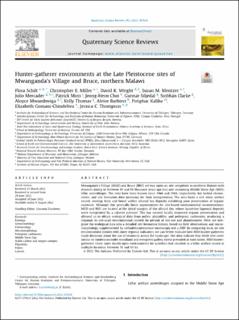| dc.contributor.author | Schilt, Flora | |
| dc.contributor.author | Miller, Christopher | |
| dc.contributor.author | Wright, David K. | |
| dc.contributor.author | Mentzer, Susan M. | |
| dc.contributor.author | Mercader, Julio | |
| dc.contributor.author | Moss, Patrick | |
| dc.contributor.author | Choi, Jeong-Heon | |
| dc.contributor.author | Siljedal, Gunnar Joakim | |
| dc.contributor.author | Clarke, Siobhán | |
| dc.contributor.author | Mwambwiga, Aloyce | |
| dc.contributor.author | Thomas, Kelly | |
| dc.contributor.author | Barbieri, Alvise | |
| dc.contributor.author | Kaliba, Potiphar | |
| dc.contributor.author | Gomani-Chindebvu, Elizabeth | |
| dc.contributor.author | Thompson, Jessica C. | |
| dc.date.accessioned | 2023-03-08T09:56:40Z | |
| dc.date.available | 2023-03-08T09:56:40Z | |
| dc.date.created | 2022-09-26T12:59:22Z | |
| dc.date.issued | 2022 | |
| dc.identifier.issn | 0277-3791 | |
| dc.identifier.uri | https://hdl.handle.net/11250/3056960 | |
| dc.description.abstract | Mwanganda's Village (MGD) and Bruce (BRU) are two open-air site complexes in northern Malawi with deposits dating to between 15 and 58 thousand years ago (ka) and containing Middle Stone Age (MSA) lithic assemblages. The sites have been known since 1966 and 1965, respectively, but lacked chronometric and site formation data necessary for their interpretation. The area hosts a rich stone artifact record, eroding from and found within alluvial fan deposits exhibiting poor preservation of organic materials. Although this generally limits opportunities for site-based environmental reconstructions, MGD and BRU are located at the distal margins of the alluvial fan, where lacustrine lagoonal deposits were overprinted by a calcrete paleosol. This has created locally improved organic preservation and allowed us to obtain ecological data from pollen, phytoliths, and pedogenic carbonates, producing a regional- to site-scale environmental context for periods of site use and abandonment. Here, we integrate the ecological data into a detailed site formation history, based on field observations and micromorphology, supplemented by cathodoluminescence microscopy and μ-XRF. By comparing local, on-site environmental proxies with more regional indicators, we can better evaluate how MSA hunter-gatherers made decisions about the use of resources across the landscape. Our data indicate that while tree cover similar to modern miombo woodland and evergreen gallery forest prevailed at most times, MSA hunter-gatherers chose more locally open environments for activities that resulted in a lithic artifact record at multiple locations between 51 and 15 ka. | en_US |
| dc.language.iso | eng | en_US |
| dc.publisher | Elsevier | en_US |
| dc.rights | Navngivelse 4.0 Internasjonal | * |
| dc.rights.uri | http://creativecommons.org/licenses/by/4.0/deed.no | * |
| dc.title | Hunter-gatherer environments at the Late Pleistocene sites of Mwanganda's Village and Bruce, northern Malawi | en_US |
| dc.type | Journal article | en_US |
| dc.type | Peer reviewed | en_US |
| dc.description.version | publishedVersion | en_US |
| dc.rights.holder | Copyright 2022 the authors | en_US |
| dc.source.articlenumber | 107638 | en_US |
| cristin.ispublished | true | |
| cristin.fulltext | original | |
| cristin.qualitycode | 2 | |
| dc.identifier.doi | 10.1016/j.quascirev.2022.107638 | |
| dc.identifier.cristin | 2055447 | |
| dc.source.journal | Quaternary Science Reviews | en_US |
| dc.relation.project | Norges forskningsråd: 262618 | en_US |
| dc.identifier.citation | Quaternary Science Reviews. 2022, 292, 107638. | en_US |
| dc.source.volume | 292 | en_US |

